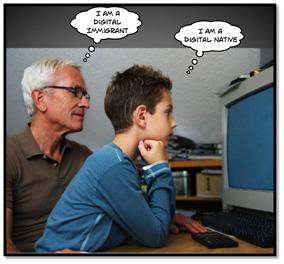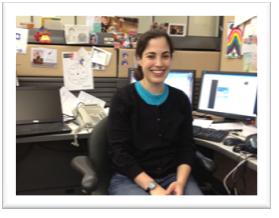Perhaps you saw the AdAge headline – “Young Consumers Switch Media 27 Times An Hour.”
Not a day. An hour.
And if you’re over 40, you probably read the story and concluded that there must have been a typo. How is it even possible to make an average of 27 media audibles an hour?
 That’s because if you grew up with TV, radio, newspapers, and magazines, it is hard to fathom the sheer volume of choices tuned-in consumers – or “digital natives” – have before them today – and how skilled they are at navigating them. Even if you’re “web savvy,” you’re just not in their league.
That’s because if you grew up with TV, radio, newspapers, and magazines, it is hard to fathom the sheer volume of choices tuned-in consumers – or “digital natives” – have before them today – and how skilled they are at navigating them. Even if you’re “web savvy,” you’re just not in their league.
You’re a “digital immigrant.”
(Hey, don’t feel bad. You’re reading a fellow immigrant’s blog.)
The news becomes a bit less daunting when you take into account the 27 number is during nonworking hours, there were only 30 respondents, and they are probably very connected.
But even if you discount these findings, the essential message will hopefully come through:
Digital “natives” shift media options 35% more than “immigrants” – those of us who have learned about digital and the web, after spending most of our lives immersed in traditional media.
We saw the beginnings of this in “The Bedroom Project,” that series of home invasions we conducted for Arbitron back in 2007. Those young people were already flexing their media muscles by using multiple devices and platforms in their dorm rooms and apartments.
And I can tell you that after moderating dozens of digital strategy meetings and brainstorms for radio stations over the past year with Lori Lewis, the addition of a “native” or two in the room makes all the difference in the world. They bring a different perspective to the table, often helping to shape the group’s thinking with their unique POV.
This has also been the case with jacAPPS, our mobile application development company. It has been enhanced by the presence of twentysomething employees who bring an entirely different mindset to our efforts.
Arbitron tells us that the average listening “occasion” is under 10 minutes long, so radio programmers already feel the pressure of the audience’s fickle tastes. And as Innerscope Research CEO Carl Marci reminds us, “…the creative bar is set higher” for advertisers…and programmers.
 A case in point is NPR’s Fresh Air. Host Terry Gross (a Jacobs Summit featured guest in 2009) is an admitted “immigrant,” but web producer Melody Joy Kramer (pictured) is a “native.” While Gross eschews social media herself, she told the Niemen Journalism Lab that she doesn’t give Kramer (@mkramer) much guidance: “I actually rely on her to tell me what direction she thinks we should head in.” It is working for Fresh Air, modernizing the show and helping Gross connect with people who are discovering it for the first time.
A case in point is NPR’s Fresh Air. Host Terry Gross (a Jacobs Summit featured guest in 2009) is an admitted “immigrant,” but web producer Melody Joy Kramer (pictured) is a “native.” While Gross eschews social media herself, she told the Niemen Journalism Lab that she doesn’t give Kramer (@mkramer) much guidance: “I actually rely on her to tell me what direction she thinks we should head in.” It is working for Fresh Air, modernizing the show and helping Gross connect with people who are discovering it for the first time.
The term “Generation Gap” has been with us since the 1960’s as young people deviated from their parents on everything from politics to sex to drugs. Our modern-day “Digital Generation Gap” presents an entirely different set of problems and challenges for content creators and marketers.
Step one? Make sure you have “digital natives” in every department of the radio station or corporation. Their views, habits, and activities will be the mainstream before we know it.
And for those of you who are personalities and hosts, the Fresh Air success story is one to build on.
Thanks, Ashleigh’s Blog for the image.
And for a cool infographic about “natives” and learning, click here. Thanks, Elnora Lowe.
- Media And Technology In 2025: Believe It Or Not! - April 18, 2025
- In Radio, You Just Never Know - April 17, 2025
- The Secret To Making A Great Podcast (And Great Radio) - April 16, 2025




Fred –
This is not just a topic for traditional media companies. Silicon valley companies are asking themselves the same question. This is from PandoDaily.com – https://bit.ly/Is6hdu
Bill Gurley of Benchmark recently published a post detailing why hiring young partners was important for any firm wanting to understand where tech was going. I don’t think anyone would argue with his observations that young people are change agents in technology. It’s a cliche– and a cliche for a reason. There is a correlation of youth and the largest, most disruptive Internet companies.
In the beginning of the film “Indie Game – The Movie” (https://www.indiegamethemovie.com/), a film about independent game designers, they had a revealing comment….”this is the first generation that was born with a game controller in their hands”.
Think about that. If we understand this then we might understand why their media habits and ours have nothing in common. Hiring a few “natives” will not be enough because this business is owned and run by “digital immigrants”.
It’s time to incubate…go all the way…hire a full staff of natives and let them do what comes naturally to this generation. Bottom line is while our industry celebrates the top 30 under 30…digital celebrates the best 20 under 20! They are a decade ahead in their thinking while we rearrange the deck chairs on…well you know the cliche’.
I knew someone would make a Titanic reference this week. Mike, the rapid change is mind-boggling, even for those of us “immigrants” who try our best to keep up. Thanks for continuing to try to turbo-charge the conversation.